No Spam Today! for Workstations
Paessler
Software, $29.95 or €29.95 (free 30 day trial available)
Windows 98SE and upward
Spam is an increasing burden for anyone that uses email, whether it be countless messages about viagra, penis or breast enlargement, and so on. It's particularly sad to note that most of it comes from America, and indeed, that probably most of it comes from a certain percentage of the population that are in it purely for financial purposes without thinking for the sheer inconvenience it causes users. I could rant about this all day, but you get the idea.
So what can you do to combat it? Apart from not publicising your email address anywhere on any website whatsoever (be particularly careful when posting online forms if they reveal your email address - some of them do) you can strike back by having some suitable anti-spam software installed on your PC. These basically work by acting as a proxy in between you and your mail server, the software fetches the mail, checks it, and then places it in your email inbox accordingly. Any emails that are flagged as spam mails normally have the subject header changed so you can see that it's clearly flagged spam.
Like most anti-spam products, No Spam Today! uses the popular spam filtering tool called Spam Assassin, which is known to be probably the best tool out there for filtering spam. In its open source form, it uses various configurations and rulesets to decide what is spam and what isn't. However, as Spam Assassin is open source, it generally isn't always readily compiled for a Windows environment for people to use. Hence, the likes of No Spam Today! and hence it not being free, like the open-source is.
As there's a fully functional 30 day trial, I took the plunge and downloaded it onto my Windows 98SE PC (a humble AMD K6-2 500 processor with 256MB of RAM). Now, previously, before the owners Bloomba decided to make their product a pay one, I used their freely available SAProxy, which did a darned fine job of filtering for spam. However, as it was the last updated version, the definitions of what is spam eventually became outdated, so I was interested to see if indeed No Spam Today! could do the job.
Incidentally, No Spam Today!, like most other spam emails, does not set up a mail filter for messages flagged as spam. You need to do this yourself in your email client - it's fairly straightforward to do. Consult the help files with your email client for more information.
Installation, Configuration and Setup
Installation was a doddle. I just went to the No Spam Today! website, clicked the download link, and waited for it to download. It was around 4.5MB, which even on a 56K modem would take less than half an hour. The installer ran, and went through the appropriate prompts, and then it came up with a configuration screen for the account manager.
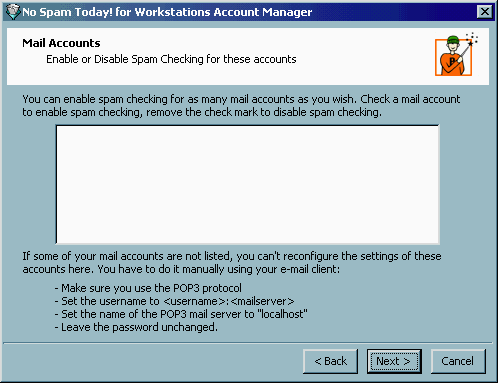
Ah yes, no mail accounts to check? Seems that No Spam Today! didn't like using Netscape Messenger 4.8 as a mail client. I temporarily installed Outlook Express, ported my account settings over, and it came up with the account in the white box this time. It does actually change the settings if you do that and click Next, so I suppose that's good. (It also does Netscape 7.x this way too, supposedly.) Anyway, if you're using Outlook Express as your email client, you're asking for trouble if you ask me. I uninstalled Outlook Express and went into Netscape Messenger to change the account settings manually (as it mentions in the bottom of the screenshot above). Here's a sample of what it looks like once you've configured your mail server correctly in Netscape 4.8:
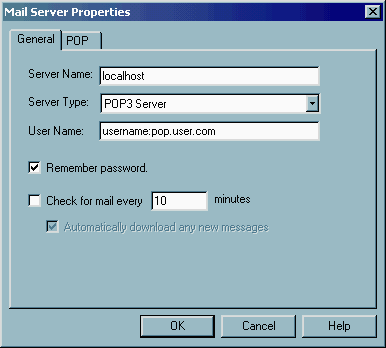
In this case, the user account is called username and the mail server is pop.user.com. As you can see, when the changes are made, you look to localhost (basically your own machine) and the user name then is the username at your email server in one line, separated by a comma, straightforward enough.
That done, when No Spam Today! runs, it places an icon in your taskbar, and unless you tell it otherwise, it will run when your PC starts up. For most people, this makes a lot of sense as you have it ready whenever you're going to check your email, and you don't forget to run it.
If you right click the taskbar icon, you can also go to some configuration screens, which look like this:
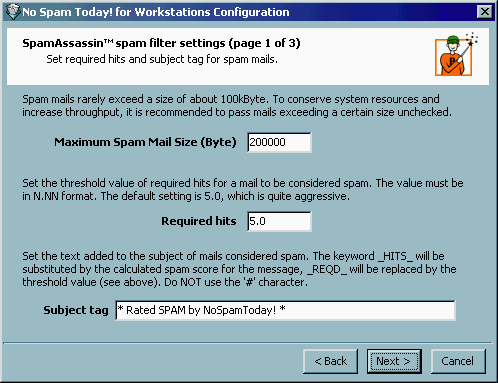
As you can see in this screenshot, you can allow emails over a certain size to go through straight away (as spam emails are normally small in length), and indeed set a threshold. Basically, when the mail is being checked, for each criteria that contributes towards spam, the mail scored a certain number of hits (or points). If it reaches 5, then it's classed as spam. Of course, you can turn this up and down if you wish, but 5's normally a pretty good default. And then the subject tag just shows what is added so you can see what message is spam.
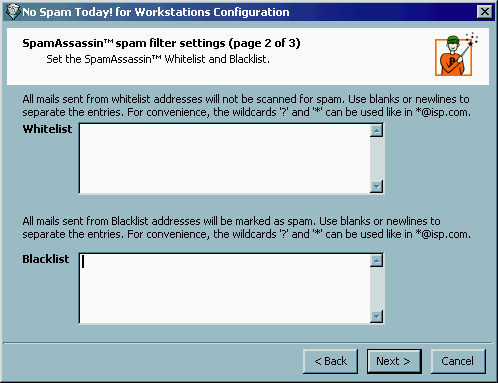
So, if you've received spam for some time, you might find that certain people definitely don't send you spam, and certain other domains do. So, for example, if your workplace is one that doesn't send spam out, you could add it to the whitelist, for example:
*@bbc.co.uk
*@ccm.ac.uk
Then any addresses from these two companies wouldn't be scanned at all for spam. Similarly, if you got spam from a lot of AOL users, you could add *@aol.com to the blacklist, if you needed to.
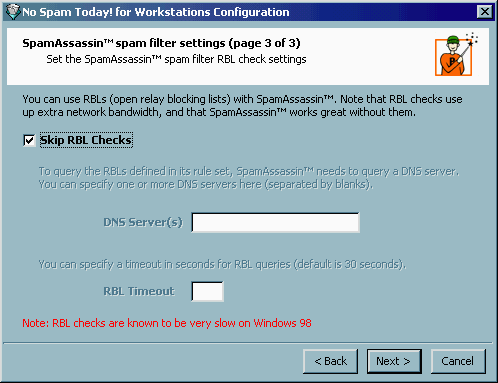
In Windows 98, I've clicked to skip RBL checks. RBLs are realtime blocking lists, and basically blocks network addresses which are known to be spam senders. If you had it enabled, you would specify the DNS server (if your ISP uses one) and a suitable timeout, just incase the checking happens to be slow when you do it.
Then, once you've set up your mail filtering rule in your email client, you're ready to go.
Time To Check The Mail
With the software installed, it was time to check my mailbox and see what came up. I had a few messages, so I went downstairs to make a coffee. I came back, and my mailbox was still being checked, and it was message 7 of 7. I was rather mystified to say the least by this slowness, so I checked through the instructions, made sure I'd done everything correct, and made sure that in the configuration screens that the RBL lists were disabled (which No Spam Today! says are very slow with Windows 98). I'd done all that, and next time I checked, it was still very slow. I then timed an average length of time to check and get each message, and timed it at around 30 seconds for each mail. That's really slow.
So, was it the speed of my PC or indeed the mail client? Well, no matter what email client I used, it was still around 30 seconds for each mail. And so then to prove it wasn't the PC, after I'd tried this out for a week, I uninstalled No Spam Today! and went back to SAProxy for testing, and it was less then 3 seconds to check each mail, which is much better. And indeed, SAProxy Pro (trial version) was a maximum of 3-4 seconds for each mail - not bad considering it checks and reformats spam mail in almost the same was as No Spam Today!
To say I was disappointed with the slow speed was an understatement. Sure, you can understand and appreciate that there are many checks needed to be made with an email to ensure that the mail actually is spam, and that's fair enough. But not when it takes so long compared to similar products. Whatever the reason, it's something Paessler really need to take a look at if possible.
But let's look at the positives. No Spam Today! does work. I'd set up a mail filtering rule to immediately delete any emails flagged as spam, so they would go in my email client's trash folder. I checked one inside the trash folder, and it looked a little like this. Note the extremely high score with this email, which must be a record!
Spam detection software has identified this message as possible spam.
The original message has been attached to this message so you can view it.
If yo do not want to see spam mails in your incoming mail folder again,
set up a filtering rule in your mail client to move all the mails tagged
with the text "* Rated SPAM by NoSpamToday! *" in the subject
line to a
different folder.
If you have questions, visit the FAQ list on our web page:
http://www.no-spam-today.com/support/faq/index_eng.html
NOTE: I've deleted the content preview, but it would normally be here.
Content analysis details: (39.7 points, 5.0 required)
pts rule name description
---- ---------------------- --------------------------------------------------
4.4 DATE_SPAMWARE_Y2K Date header uses unusual Y2K formatting
4.2 IMPOTENCE BODY: Impotence cure
0.1 TW_JH BODY: Odd Letter Triples with JH
0.1 TW_JP BODY: Odd Letter Triples with JP
0.1 TW_KQ BODY: Odd Letter Triples with KQ
1.9 INCREASE_SEX BODY: Talks about a bigger drive for sex
1.1 PENIS_ENLARGE BODY: Information on getting larger penis/breasts
0.1 TW_NZ BODY: Odd Letter Triples with NZ
0.1 TW_OC BODY: Odd Letter Triples with OC
0.6 PENIS_ENLARGE2 BODY: Information on getting larger penis/breasts
1.2 GUARANTEED_STUFF BODY: Guaranteed Stuff
0.1 TW_PM BODY: Odd Letter Triples with PM
0.1 TW_PQ BODY: Odd Letter Triples with PQ
0.1 TW_QO BODY: Odd Letter Triples with QO
0.1 TW_QZ BODY: Odd Letter Triples with QZ
0.1 TW_TG BODY: Odd Letter Triples with TG
0.1 TW_VJ BODY: Odd Letter Triples with VJ
0.1 TW_VR BODY: Odd Letter Triples with VR
0.1 TW_ZF BODY: Odd Letter Triples with ZF
0.1 TW_ZQ BODY: Odd Letter Triples with ZQ
0.1 TW_ZR BODY: Odd Letter Triples with ZR
0.1 TW_ZT BODY: Odd Letter Triples with ZT
1.1 BANG_GUARANTEE BODY: Something is emphatically guaranteed
0.1 TW_ZZ BODY: Odd Letter Triples with ZZ
4.3 MONEY_BACK BODY: Money back guarantee
0.1 TW_EG BODY: Odd Letter Triples with EG
0.6 CLICK_BELOW_CAPS BODY: Asks you to click below (in capital letters)
0.1 TW_GJ BODY: Odd Letter Triples with GJ
0.1 TW_GK BODY: Odd Letter Triples with GK
0.1 TW_HV BODY: Odd Letter Triples with HV
0.1 HTML_FONTCOLOR_RED BODY: HTML font color is red
0.1 HTML_FONTCOLOR_GREEN BODY: HTML font color is green
0.1 HTML_FONTCOLOR_UNKNOWN BODY: HTML font color is unknown to us
0.1 MIME_HTML_ONLY BODY: Message only has text/html MIME parts
0.0 HTML_MESSAGE BODY: HTML included in message
0.5 HTML_LINK_CLICK_CAPS BODY: HTML link text says "CLICK"
0.1 HTML_FONT_BIG BODY: HTML has a big font
0.5 HTML_40_50 BODY: Message is 40% to 50% HTML
0.1 HTML_LINK_CLICK_HERE BODY: HTML link text says "click here"
0.7 MIME_HTML_NO_CHARSET RAW: Message text in HTML without charset
1.9 DATE_IN_FUTURE_06_12 Date: is 6 to 12 hours after Received: date
4.3 SORTED_RECIPS Recipient list is sorted by address
1.8 FORGED_AOL_HTML AOL can't send HTML message only
0.0 FORGED_AOL_TAGS AOL mailers can't send HTML in this format
1.1 MIME_HTML_ONLY_MULTI Multipart message only has text/html MIME parts
0.1 MISSING_OUTLOOK_NAME Message looks like Outlook, but isn't
1.2 MISSING_MIMEOLE Message has X-MSMail-Priority, but no X-MimeOLE
4.3 FORGED_MUA_AOL_FROM Forged mail pretending to be from AOL (by From)
1.7 HTML_MIME_NO_HTML_TAG HTML-only message, but there is no HTML tag
The original message was not completely plain text, and may be unsafe to
open with some email clients; in particular, it may contain a virus,
or confirm that your address can receive spam. If you wish to view
it, it may be safer to save it to a file and open it with an editor.
The original message is encapsulated, so you can click on a link at the bottom of the message if you want to read it as it was originally sent, but with this email having HTML, it's probably a lot safer if you don't. As you can see, it puts the Spam Assassin engine to good use, and displays just some of the many checks that are done to flag spam. As you can see, the sender forged the address pretending to be from AOL, and that itself almost alone would have scored five points. Not least as AOL can't send HTML messages only, so add the 1.8 to it, and just for those two reasons it'd have been captured. So there you go.
Similar spam messages were displayed in the same way and were safely readable as plain text so you could see the results appropriately and just see how much work is done to ensure a safe capture of proper spam.
With the spam it captured, I was impressed that it also used a Bayesian filter to learn itself what was flagged as spam and how eventually you could train it well enough to capture others. The other nice feature was that if you wanted to, you could configure the subject line amendment to as you wish so you could see them really clearly if needed. And it did the job in getting rid of a fair amount of proper spam.
Here it is in action as it scanned mails:
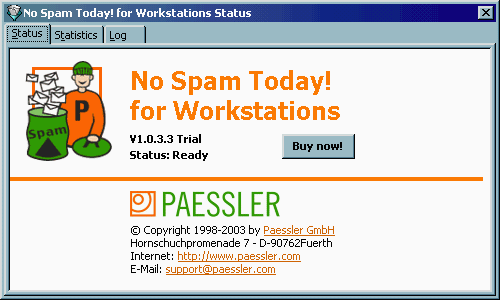
When you double click the taskbar, the status comes up on screen. Now let's look at the all important stats:
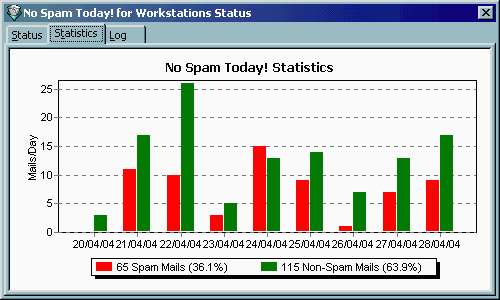
As you can see, from the start of the trial, to the end of my testing, I got a total of 180 email messages, about average for the week. 65 emails were flagged correctly as spam by No Spam Today!, which is not bad at all. Note on April 24th I got more spam than non-spam. Now, here's the balance twister. I also in this time received 34 mails, which although were not flagged as spam, clearly were spam. This means in reality I got the following:
99 spam mails (55%)
81 non-spam mails (45%)
It also means that 65 out of 99 mails were correctly flagged by No Spam Today!, giving it a 65.6% success rate. Not bad really, and that helps a fair bit, but it could do better. The most common thing that caught it out was Viagra spelt with a funny accented "i" - maybe something to put in the next build as a custom rule, methinks.
As the mail is being checked, you can also see a log of the checks:
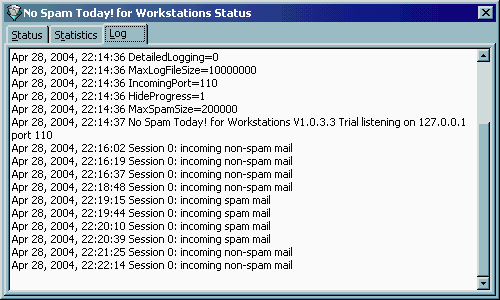
And as you can see, there's the spam being caught, big time.
Overall Impression
What did I think of it? Well, as a tool designed to help email users catch the evil spam that comes in, it was pretty successful at managing to catch spam, and its success rate wasn't too bad at all considering that spammers always use new techniques to be one step ahead. However, what will put workstation users off is the very slow speed that it took to check the mails coming in. I don't mind a small delay, but the 30 seconds or so was just too much for me by the end of testing, and was proving to be a little on the frustrating side to say the least. Not least if you're waiting on an important email coming through and you're there twiddling your thumbs whilst waiting for it.
However, if you're prepared to put up with the wait, it's a fairly easy to use tool, configures itself for most mail programs (don't forget to add your mail filtering rule, though) and also works in the background effectively, doing a job that, if America actually took any action to combat spammers, shouldn't have to exist, and doing it reasonably well.
Warren's rating: 67%